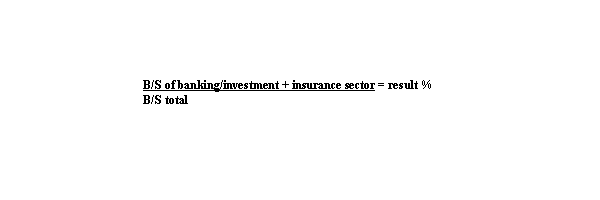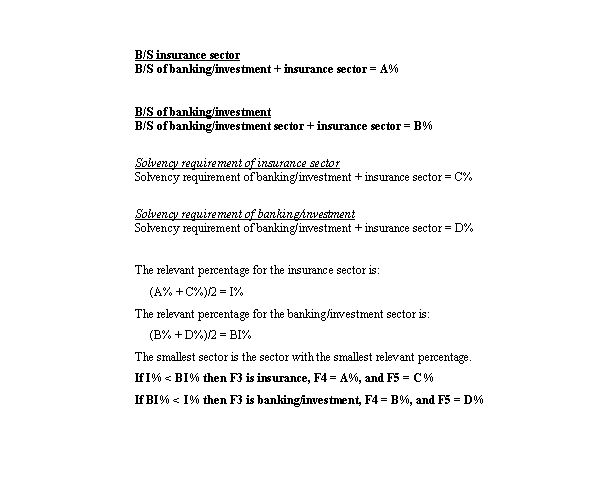PRU 8 Ann 3G 1Guidance Notes for Classification of Groups
This annex consists only of one or more forms or templates. Forms and templates are to be found through the 'Forms' link under Useful Links section at www.fsahandbook.info or on the Handbook CD-ROM.1
Purpose and scope
The form is designed to identify groups and sub-groups that are likely to be financial conglomerates under the Financial Groups Directive. A group may be a financial conglomerate if it contains both insurance and banking/investment businesses and meets certain threshold tests. The FSA needs to identify conglomerates with their head offices in the EEA and those with their head offices outside the EEA, although this does not necessarily mean that the latter will be subject to EEA conglomerate supervision.
This form's purpose is to enable the FSA to obtain sufficient information so as to be able to determine how likely a group/sub-group is to be a financial conglomerate. In certain cases this can only be determined after consultation with the other EU relevant competent authorities. A second purpose of the form is therefore to identify any groups and sub-groups that may need such consultation so that this can be made as soon as possible. This should allow firms time to prepare to comply.
A copy of this form can be found on the FSA's Financial Groups Website with current contact details.
The definition of financial conglomerate includes not only conventional groups made up of parent-subsidiary relationships but groups linked by control and "consolidation Article 12(1) relationships". If this is the case for your group, please submit along with this form a statement that this is the case. Please include in that statement an explanation of how you have included group members not linked by capital ties in the questionnaire calculations.
A consolidation Article 12(1) relationship arises between undertakings in the circumstances set out in Article 12(1) of the Seventh Company Law Directive. These are set out in the Handbook Glossary (in the definition of consolidation Article 12(1) relationship). Broadly speaking, undertakings come within this definition if they do not form a conventional group but:
Please use the most recent accounts for the top level company in the group together with the corresponding accounts for all subsidiaries and participations that are included in the consolidated accounts. Please indicate the names of any significant subsidiaries with a different year-end from the group's year-end.
Please note the following:
- (a)
Branches should be included as part of the parent entity.
- (b)
Include in the calculations overseas entities owned by the relevant group or sub-group.
- (c)
There are only two sectors for this purpose: banking/investment and insurance.
- (d)
You will need to assign non-regulated financial entities to one of these sectors:
- •banking/investment activities are listed in - IPRU Banks CS 10 Appendix A
- • insurance activities are listed in - IPRU Insurers Annex 11.1 and 11.2 p 163-168.
- • Any operator of a UCITS scheme, insurance intermediary, mortgage broker and mixed financial holding company does not fall into the directive definitions of either financial sector or insurance sector. They should therefore be ignored for the purposes of these calculations.
For the purpose of completing section 2 of the form relating to the threshold tests, the following guidance should be used. However, if you consider that for your group there is a more appropriate calculation then you may use this calculation so long as the method of computation is submitted with the form.
Generally, use total (gross) assets for the balance sheet total of a group/entity. However, investments in other entities that are part of the group will need to be deducted from the sector that has made the investment and the balance sheet total of the entity is added to the sector in which it operates.
Our expectation of how this may be achieved efficiently is as follows:
- (i)
Off-balance-sheet items should be excluded.
- (ii)
Where off-balance sheet treatment of funds under management and on-balance sheet treatment of policy holders' funds may distort the threshold calculation, groups should consult the FSA on the appropriateness of using other measures under article 3.5 of the Financial Groups Directive.
- (iii)
If consolidated accounts exist for a sub-group consisting of financial entities from only one of the two sectors, these consolidated accounts should be used to measure the balance-sheet total of the sub-group (i.e. total assets less investments in entities in the other sector). If consolidated accounts do not exist, intra-group balances should be netted out when calculating the balance sheet total of a single sector (but cross-sector intra-group balances should not be netted out).
- (iv)
Where consolidated accounts are used, minority interests should be excluded and goodwill should be included.
- (v)
Where accounting standards differ between entities, groups should consult the FSA if they believe this is likely materially to affect the threshold calculation.
- (vi)
Where there is a subsidiary or participation in the opposite sector from its parent (i.e. insurance sector for a banking/investment firm parent and vice versa), the balance sheet amount of the subsidiary or participation should be allocated to its sector using its individual accounts.
- (vii)
The balance-sheet total of the parent entity/sub-group is measured as total assets of the parent/sub-group less the book value of its subsidiaries or participations in the other sector (i.e. the value of the subsidiary or participation in the parent's consolidated accounts is deducted from the parent's consolidated assets).
- (viii)
The cross-sector subsidiaries or participations referred to above, valued according to their own accounts, are allocated pro-rata, according to the aggregated share owned by the parent/sub-group, to their own sector.
- (ix)
If the cross-sector entities above themselves own group entities in the first sector (i.e. that of the top parent/sub-group) these should (in accordance with the methods above) be excluded from the second sector and added to the first sector using individual accounts.
Generally, the solvency requirements should be according to sectoral rules (that is EEA prudential sectoral legislation - see Glossary). However, for convenience, you may choose to use either EEA rules, FSA rules or local rules. But if this choice makes a significant difference, either with respect to whether the group is a financial conglomerate or with respect to which sector is the biggest, you should consult with the FSA. Non-regulated financial entities should have proxy requirements calculated on the basis of the most appropriate sector. If sub-groups submit single sector consolidated returns then the solvency requirement may be taken from those returns.
Our expectation of how this may be achieved efficiently is as follows:
- (i)
If you complete a solvency return for a sub-group consisting of financial entities from only one of the two sectors, the total solvency requirement for the sub-group should be used.
- (ii)
Solvency requirements taken must include any deductions from available capital so as to allow the appropriate aggregation of requirements.
- (iii)
Where there is a regulated subsidiary or participation in the opposite sector from its parent/sub-group, the solvency requirement of the subsidiary or participation should be from its individual regulatory return. If there is an identifiable contribution to the parent's solvency requirement in respect of the cross-sector subsidiary or participation, the parent's solvency requirement may be adjusted to exclude this.
- (iv)
Where there is an unregulated financial undertaking in the opposite sector from its parent/sub-group, the solvency requirement of the subsidiary or participation should be one of the following:
- (a)
(a) as if the entity were regulated by the FSA under the appropriate sectoral rules;
- (b)
(b) using EU minimum requirements for the appropriate sector; or
- (c)
(c) using non-EU local requirements* for the appropriate sector.
Please note on the form which of these options you have used, according to the country and sector, and whether this is the same treatment as in your latest overall group solvency calculation.
- (a)
- (v)
For banking/investment requirements, use the total amount of capital required.
- (vi)
For insurance requirements, use the Required Minimum Margin:
- (a)
(a) UK firms, Form 9: for general insurance business = capital resources requirement [line 29]; for long-term insurance business = capital resources requirement (higher of Minimum Capital Requirement and Enhanced Capital Resources Requirement) [line 52].
- (b)
(b) Overseas firms, either:
- • the local requirement*;
- • the EU minimum; or
- • the FSA requirement.
- * N.B. local requirements may only be used if they are at least equivalent to the EU minimum (designated states or territories). However, local requirements of a non-designated state or territory may be used if the resulting ratio in F5 is significantly below the 10% threshold (for this purpose "significantly below" may be taken to mean <5%).
- (a)


